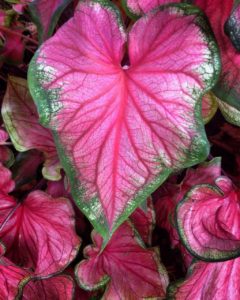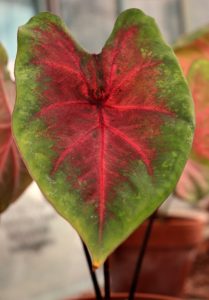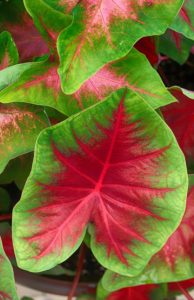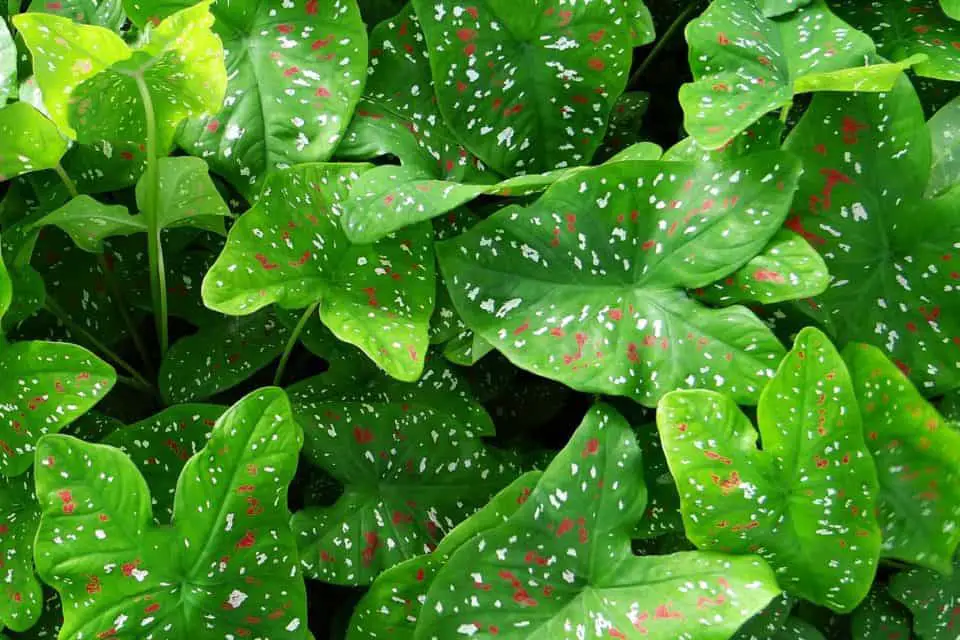Some links in the post are affiliate links and I get a commission from purchases made through some links found in the post.
Gardening beginners often start with low-maintenance plants that are also easy to grow.
Syngonium and Caladium are such easy plants that have fast appealed to gardeners who want a bit of life in their indoors.
While these plants have many similarities to the point that some people mistake them to be the same plant, they have quite distinct differences.
Today, we look at what makes the syngonium vs caladium similar and what sets them apart from each other.
The main differences between the syngonium and the caladium is the appearance, soil conditions, lighting needs and toxicity.
Caladiums when grown indoors prefer indirect light and when grown outdoors, prefer full to partial shade.
Syngonium do not need much light, and you can pretty much grow them in any spot but direct sunlight can burn them.
Syngonium vs Caladium – Similarities
Most people have trouble telling these plants apart owing to their undeniable similarity in appearance.
However, their common traits go beyond what meets the eye and also goes into:
Origin
Both plants originate from tropical forests and will do better in humid regions.
As long as you give them adequate lighting, temperature variation, and some misting here and there, the plants should do well.
This similarity also makes it easier to grow them together without one plant suffering as a result.
Watering Requirements
These plants may require extra care at an early stage as they establish.
However, once they are mature, you can pretty much water them together, and none would suffer.
You can even grow them in the same spot and reduce your watering hassle. How does that sound?
If you need help watering your plants, try using this automatic drip irrigation kit.
Pests & Diseases
 Given that the plants come from the same family, they do have another thing in common: pests and diseases.
Given that the plants come from the same family, they do have another thing in common: pests and diseases.
On the downside, it means that if you grow them together, they will infest each other with pests when one suffers an attack.
On the plus side, it means you will look out for specific pests and diseases and will only need to find the same cures.
It’s both messy and simple, depending on what card you’re dealt.
Flowering
In most cases, you will not see any flowering in these plants, especially when you go for modern varieties.
But if it does happen, you will notice that the petioles can only produce one flower in both instances.
That’s right- they are both mono-flowering plants! If you don’t want the flowers and instead want to focus on the foliage and stalks, you can cut them off once they appear.
You will appreciate the healthy plant that arises from this immediacy.
Syngonium vs Caladium – Differences
As we have seen, there’s a lot these plants share. However, you also need to be aware that they have some interesting differences such as:
Syngonium vs Caladium – Taxonomy
Did you know that the Syngonium and Caladium are cousins? It explains why they look so similar. Let’s break this down a bit.
These two come from the same family- Araceae. However, when it comes to the genus and species, they go their separate ways.
The Caladium, scientifically known as Caladium bicolor, comes from the Caladium Vent genus.
It also goes by the name heart of Jesus, elephant ear, and angel wings.
The Syngonium, on the other hand, goes by the scientific name Syngonium podophyllum and comes from the genus Syngonium Schott.
It also goes by the names goose’s foot, five fingers, and arrowhead vines.
Understanding the roots of any plant gives you a higher chance of giving it the care it deserves.
That’s why so many gardeners want to understand the whole taxonomy line of their plants.
It becomes easier to diagnose growing problems and even prevent them before they occur.
For example, with Caladiums, you will learn that it’s hard to keep the bulbs healthy, and there’s a lot that goes into the preliminary care.
For this reason, some people gravitate towards propagating Syngonium seedlings to increase their chances of success.
With Caladium, it gets even more interesting as it has a large range of cultivars available in orange, pink, white, red, and green.
Most of the time, you won’t even know which cultivar you’re getting because nurseries often don’t name them.
You’ll see a vibrant-looking plant, and the nursery owner will point out that it comes from the c. bicolor line. Some of the popular options include:
Creamsicle
This variety grows fast and strong and has large green leaves with white veins and red accents.
For a plant that dramatically uplifts the room’s appearance, this would be a good choice.
White Christmas
For a simple look, this plant with large arrow-like leaves with a whitish dusting on its leaves works the magic.
Miss Muffet
With a stunted growth rate and an optimal height of only eight inches, this plant has more than earned its name.
It features lime-green leaves with some pink spots on the surface.
Puppy Love
This variety is relatively new and appeals to gardeners for its pink leaves with green accents.
People living in colder climates can expose this plant to the sun without damaging its leaves.
Syngonium vs Caladium – Appearance

Syngoniums are trailing or climbing vines whose leaf structure undergoes a range of changes as the plant matures.
At a young age, the leaf has a simple arrow shape, but it develops a deeply lobed or divided leaf as it ages.
The hue also changes with time and can be anything from dark green to light green to pink down to white. It grows throughout the year in indoor conditions.
Caladiums have large thin arrow-shaped leaves in the hues white, red, pink, and green with apparent stripes and veins.
Their leaves resemble flowers. Given that these are tuberous plants, the foliage is only available from spring to autumn.
Of the two plants, you will notice that caladiums have bolder colors while syngoniums have paler hues.
If you are enjoying this article, check out the types of syngonium
Syngonium vs Caladium – Growing Requirements
Both these plants come from the tropical and subtropical rain forests in Central and South America.
As such, they thrive in humid regions as long as you water them right and give them well-draining and aerated soils. However, they have some slight differences:
Syngonium vs Caladium – Soil Conditions
The Caladium does best in rich and well-draining soil with a slightly acidic pH level.
Given that it’s a tuber plant, you have to keep the soil moist at all times and cannot run the risk of letting it dry.
However, the soil should not be soggy. In most cases, the plant will do well when watered at least three times a week.
Again, this depends on how hot the area is. Caladiums are highly sensitive to drought.
If you live in a hot area, place a pebble tray filled with water under the pot to account for added humidity.
It will slowly mist the plant and keep the water loss rate on the minimum. If you notice browning on the leaves’ edges, you need to look into if the plant is getting less water than it needs.
Syngonium does well in moist and well-drained soil and is not too particular about the nutrient profile.
As for the pH, you should aim at a neutral to acidic level, ensuring that the soil stays moist most of the time.
It’s a vine and will not suffer much damage if you neglect it for a while. But for the most part, aim to water the plant twice or thrice each week.
You don’t need to place a water-filled pebble tray underneath the pot, but you can still use it to increase the humidity.
For both plants, a compost to perlite ratio of 4:1 should be enough to allow for drainage.
Syngonium vs Caladium – Lighting Needs
Caladiums are tropical perennial plants that will do well in hardiness zones 9-10.
When growing indoors, they prefer indirect light, and when outdoors, they are better off in full to partial shade.
Generally, they are highly sensitive to light, and if you directly expose them to the sun, they will start browning.
Given the thinness of their leaves, you have to go a step further in protecting them by using blinds on the windows or placing them in the shade.
Syngoniums grow in hardiness zones 10-12 and will do well in partial shade but are quite adaptable to light changes.
They do not need much light, and you can pretty much grow them in any spot in the house.
However, the greener leaf varieties are the best for dimly lit spaces, while the less green species do well in more light.
Even so, you should not leave the plant in direct sunlight as this can burn the leaves.
Syngonium vs Caladium – Toxicity
Both these plants can do well indoors and outdoors, provided you give them the proper care.
If you have pets and children in the home, position the plants higher to make it hard for the pets and kids to reach them to avoid poisoning cases.
Caladiums are toxic to both pets and people. Poisoning symptoms in humans include swelling, vomiting, diarrhea, and eye pain.
Pets will exhibit excessive drooling, swelling, signs of distress, trouble swallowing, and vomiting.
Syngoniums are only toxic to pets, and poisoning symptoms include reduced appetite, signs of pain, vomiting, pawing at the mouth, and irritation signs.
If you enjoyed this, check out our comparison of a philodendron selloum vs xanadu.
Final Thoughts
 If you’re after colorful leaves to adorn and transform your space, do not shy back from growing these plants.
If you’re after colorful leaves to adorn and transform your space, do not shy back from growing these plants.
Not only do they work for beginners who barely know anything about gardening, but they are also good choices for experienced gardeners.
While they have a ton of similarities, you should also consider what’s different about them. Only then can you give each plant the care it needs.
Happy Gardening!
Before you go, here are some more related articles I encourage you to read below to help solve more of your gardening issues:
Pothos N Joy vs Pearls and Jade
Philodendron Selloum vs Xanadu
Written by: Daisy Njeri


